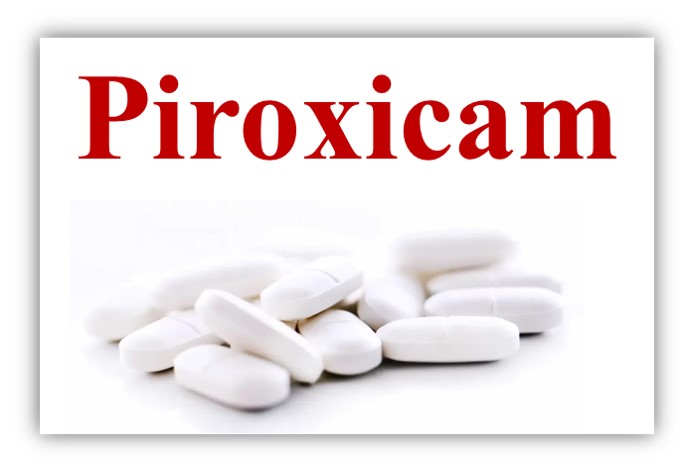OVERVIEW
Piroxicam is a nonsteroidal anti-inflammatory drug (NSAID) belonging to the oxicam class, primarily used for the management of pain and inflammation associated with conditions such as osteoarthritis and rheumatoid arthritis.
DOSAGE
For Adults
Rheumatoid Arthritis:
- 20 mg orally once a day.
- Alternatively, 10 mg can be taken twice a day.
Osteoarthritis:
Same as rheumatoid arthritis: 20 mg once daily or 10 mg twice daily.
For Children
Its safety and efficacy have not been established in children under 18 years of age, and dosage should be determined by a healthcare provider.
Missed Dose
If you miss a dose, take it as soon as you remember, unless it is almost time for your next dose. In that case, skip the missed dose and resume your regular schedule. Do not take a double dose.
MECHANISM OF ACTION
Inhibition of Cyclooxygenase
Piroxicam reversibly inhibits COX-1 and COX-2 enzymes. COX-1 is involved in the production of prostaglandins that protect the gastric mucosa and regulate platelet function, while COX-2 is induced during inflammation and is responsible for the production of pro-inflammatory prostaglandins.
Reduction of Prostaglandin Synthesis
By blocking these enzymes, piroxicam reduces the levels of prostaglandins in peripheral tissues. This reduction helps reduce pain and inflammation associated with conditions such as rheumatoid arthritis and osteoarthritis.
Effects on Leukocyte Migration
Piroxicam also inhibits the migration of leukocytes to sites of inflammation, further enhancing its anti-inflammatory effects. In addition, it prevents the formation of thromboxane A2, a compound that promotes platelet aggregation.
Analgesic and Antipyretic Properties
This medicine exhibits analgesic (pain reliever) and antipyretic (fever reducer) properties, making it effective for managing various inflammatory conditions.
ADVERSE DRUG REACTIONS
Gastrointestinal Risks
Ulcers and bleeding: Piroxicam can cause serious gastrointestinal problems, such as ulcers, bleeding, and perforations in the stomach or intestines. These can happen without warning and can be fatal, especially in older adults or people with a history of ulcers.
Cardiovascular Risks
Heart attack and stroke: The risk of serious cardiovascular events, including heart attack and stroke, is increased, especially with long-term use or in patients who already have heart disease. Symptoms may include chest pain, shortness of breath, or sudden numbness.
Kidney Damage
Symptoms of kidney problems may include decreased urination, swelling in the feet or ankles, and unusual fatigue. Kidney damage can occur even with short-term use.
Liver Damage
Symptoms may include loss of appetite, pain in the upper right abdomen, fatigue, jaundice (yellowing of the skin or eyes), and dark urine.
Severe Skin Reactions
Piroxicam can cause serious skin reactions such as Stevens-Johnson syndrome (SJS) and toxic epidermal necrolysis (TEN), which can be life-threatening. Symptoms include painful red or purple skin rashes that blister and peel.
Allergic Reactions
Severe allergic reactions can manifest as difficulty breathing, swelling of the face or throat, hives, or chest pain. Immediate medical attention is needed if these symptoms occur.
Gastrointestinal Issues
Nausea, vomiting, diarrhea, constipation, heartburn, and abdominal pain.
Central Nervous System
Dizziness, headache, and vertigo.
Skin Reactions
Rash and itching.
Fluid Retention
Edema (swelling in feet or ankles).
DRUG-DRUG INTERACTIONS
NSAIDs
Increased risk of GI toxicity: Concomitant use with other NSAIDs (eg, aspirin, ibuprofen, naproxen) may increase the risk of gastrointestinal ulcers and bleeding without providing additional benefit.
Methotrexate
Risk of toxicity: Piroxicam may increase levels of methotrexate in the body, increasing the risk of toxicity, which may manifest as nausea, vomiting, and kidney dysfunction.
Anticoagulants
Bleeding Risk: Coadministration may increase the risk of serious gastrointestinal bleeding.
Blood Pressure Medications
Decreased Efficacy: Piroxicam may reduce the efficacy of certain antihypertensive agents, including ACE inhibitors and diuretics, which may lead to an increase in blood pressure.
Corticosteroids
GI ulceration: This combination increases the risk of gastrointestinal ulceration and bleeding.
Cyclosporine
Nephrotoxicity: This combination may increase the risk of kidney damage.
Lithium
Increased plasma levels: Piroxicam may increase blood lithium levels due to its high protein binding, which requires careful monitoring.
Pemetrexed
Increased Toxicity: Co-administration may increase the risk of myelosuppression and renal toxicity.
USE
Rheumatoid Arthritis
Piroxicam is commonly prescribed to reduce pain, swelling, and stiffness in patients suffering from rheumatoid arthritis. Rheumatoid arthritis is an autoimmune disease that causes long-term inflammation in the joints.
Osteoarthritis
It is also effective in treating osteoarthritis, a degenerative joint disease that causes the breakdown of cartilage and resulting pain and stiffness.
Ankylosing Spondylitis
This medicine may be prescribed for ankylosing spondylitis, a type of arthritis that primarily affects the spine.
Dysmenorrhea
Piroxicam is used to relieve menstrual pain (dysmenorrhea), which helps to reduce the discomfort during menstruation.
Postoperative Pain
It can also be used to manage pain after surgical procedures or childbirth.
Muscle Pain
Piroxicam can be effective for general muscle pain and inflammation.


1 thought on “Piroxicam”